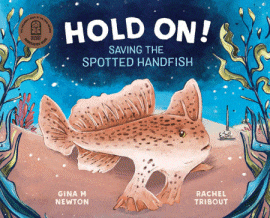
Hold On! Saving the Spotted Handfish
Hold On! Saving the Spotted Handfish
Gina M. Newton
Rachel Tribout
CSIRO Publishing, 2020
32pp., hbk., RRP $A24.99
9781486311842
Where the Derwent River spreads out to meet the Tasman Sea on the southeastern coast of Tasmania lives Handstand, a spotted handfish and one of just 1000 left of a species that the dinosaurs would have recognised. A species of anglerfish, Handstand lures prey using a fleshy growth on her head, which acts like a fishing rod and lure, even including a “light” that attracts the worms and crustaceans on the deep sea floor. But even more amazing is that she has hands – pectoral fins that have adapted to allow her to walk along the seabed because without a swim bladder, she can’t swim.
This is just some of the information contained in this remarkable book, told by Handstand herself, and introducing this highly endangered species to young readers. Being one of the first marine fish species to be listed on the IUCN Red List , and one of just 14 species from the hundreds that used to be in the oceans (all of which are Australian). not only does Handstand raise awareness of her species for those looking to investigate a not-so-familiar endangered species, but she conveys a strong message of the need to protect and conserve both the marine environment and those that live within it.
Presented in a way that engages the reader with Handstand’s story entwined and embedded with facts and accompanied by biologically-correct illustrations which have a childlike appeal, this book has been shortlisted for both the CBCA Even Pownall Award for Information Books for 2021 and the Wilderness Society Environment Award for Children’s Literature: Non fiction 2021, both accolades that are richly deserved because not only is the spotlight thrown on the future of the spotted handfish , but there is also a raised awareness of the needs of and threats to the ocean environment generally. If climate change, chemical pollution, rubbish, fishing nets and invaders like the Northern Pacific Seastar are threatening this tiny creature, then others must be at risk too.
Extensive teachers’ notes are available and the book uses a variety of graphic techniques that students could adopt and adapt to bring their own reports to life, making it a book that as well as deserving its award nominations, definitely deserves a place in the library’s collection.
Twenty-one red handfish hatched in successful Tasmanian conservation breeding program
